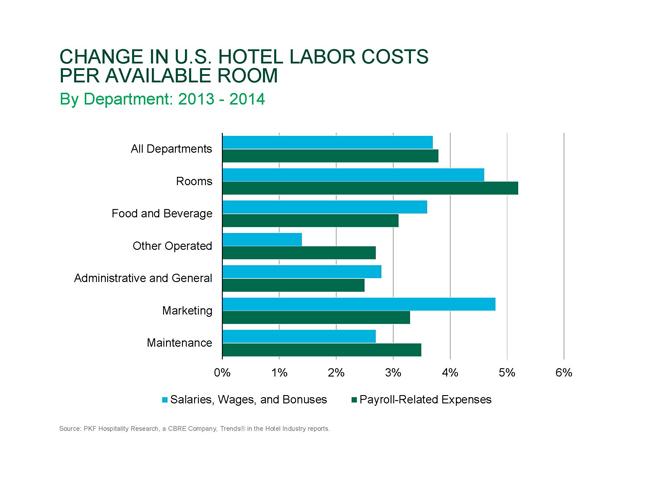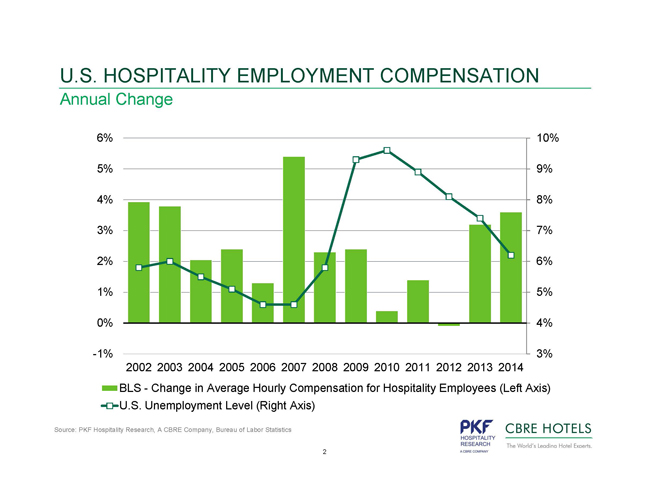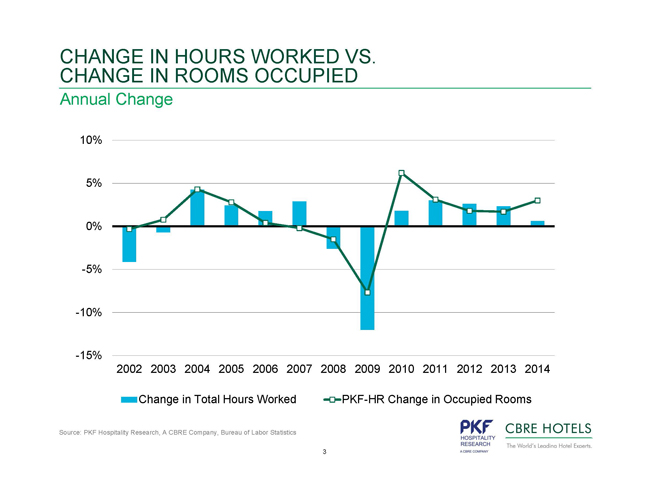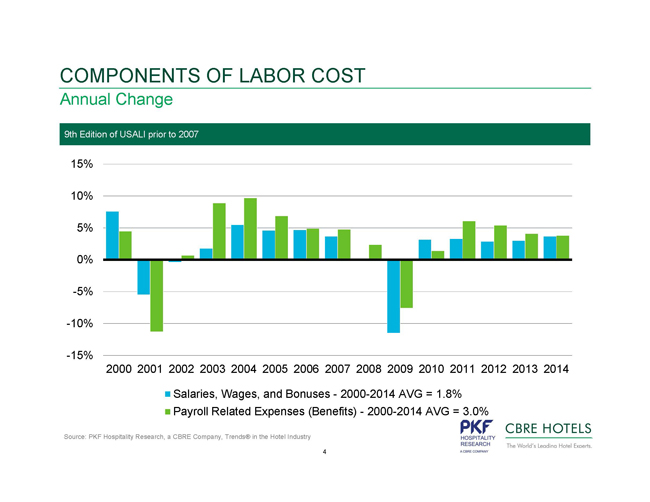By Robert Mandelbaum
One of the most significant findings of the 2015 edition of Trends® in the Hotel Industry was the 4.9 percent rise in operating expenses (ExPAR) for U.S. hotels during 2014. This is the greatest annual increase in ExPAR since 2007, and uncharacteristic of the strict cost controls implemented during the initial years of the recovery from the 2009 great recession. Trends® in the Hotel Industry is the annual survey of hotel operating statements conducted by PKF Hospitality Research (PKF-HR), a CBRE Company.
Controlling Components
When investigating hotel operating expenses, the first items we look at are labor costs. In 2014, labor costs have averaged 31.5 percent of total revenue, and 44.2 percent of total expenses. Over the years, these two ratios have remained fairly consistent, indicating that hotel managers have done a good job of adjusting costs relative to changes in market conditions. This is possible because labor costs are a highly variable expense.
Sometimes external factors will influence labor costs. In general, these external factors tend to be less controllable by management. During 2014, the external factor that had the greatest influence on labor costs was the continuing decline in the national unemployment rate. According to the Bureau of Labor Statistics (BLS), the national unemployment rate dropped to 6.2 percent in 2014. This contributed to the 3.6 percent increase in the average hourly compensation rate for workers in the U.S. hospitality industry. From 2010 through 2012 it was the high levels of unemployment that suppressed compensation growth to less than 1.5 percent.
Per the 10th edition of the Uniform System of Accounts for the Lodging Industry, there are two components to total labor costs. In 2014, salaries, wages, and bonuses accounted for 70.4 percent of total labors costs with the remainder was attributable to payroll-related expenses (employee benefits).
In 2014, the salaries, wages, and bonuses component of labor costs increased by 3.7 percent, while the payroll-related component grew by 3.8 percent. This differs from recent history when mandated benefits and rising taxes caused the payroll-related cost component to be the dominant driver of labor costs.
To offset the increasing pressures on salaries and wages, hotel managers responded by controlling staffing levels. In 2014, PKF-HR estimates that the total hours worked by employees at the hotels in the Trends® survey grew by a mere 0.6 percent. Considering that the number of occupied rooms in the Trends® sample increased by 3.0 percent, it is clear that operators were able to achieve significant increases in employee productivity during the year.
Departmental Cost Controls
In 2014, the greatest increases in labor costs were observed in the Rooms and Sales and Marketing departments. Rooms department labor consists of room attendants, front desk clerks, bell staff and laundry workers whose schedules are significantly influenced by the volume of business at the hotel. Therefore, the 3.0 percent increase in occupied rooms explains most of the 4.7 rise in Rooms department labor costs for the year.
Within the Sales and Marketing department, it was the 4.8 percent increase in salaries, wages, and bonuses that drove the 4.5 percent increase in total department labor costs. Of all the departments, employees in the Sales and Marketing department have the highest incidence of incentive-related compensation. With occupancy, RevPAR, and profit levels hitting all-time record levels, it is assumed that Sales and Marketing department personnel were able to earn significant bonuses in 2014.
Excluding Other Operated departments which vary from property to property, the departments that saw the least increase in labor costs during 2014 were Administrative and General and Maintenance. Staffing in these departments is not significantly influenced by changes in occupied rooms.
Cost Challenges
In 11 of the past 15 years, external factors have had the greatest impact on the payroll-related component of labor costs. Hoteliers have had to face the pressure of rising taxes, and increases in mandated employee benefits. Starting in 2014, and looking towards the future, it appears that hotel operators will now have to focus on the salaries, wages, and bonuses component. Low levels of unemployment, combined with the increasing incidence of minimum and living wage legislation, will continue to put upward pressure on the salaries and wages hotels will have to pay their staff.





